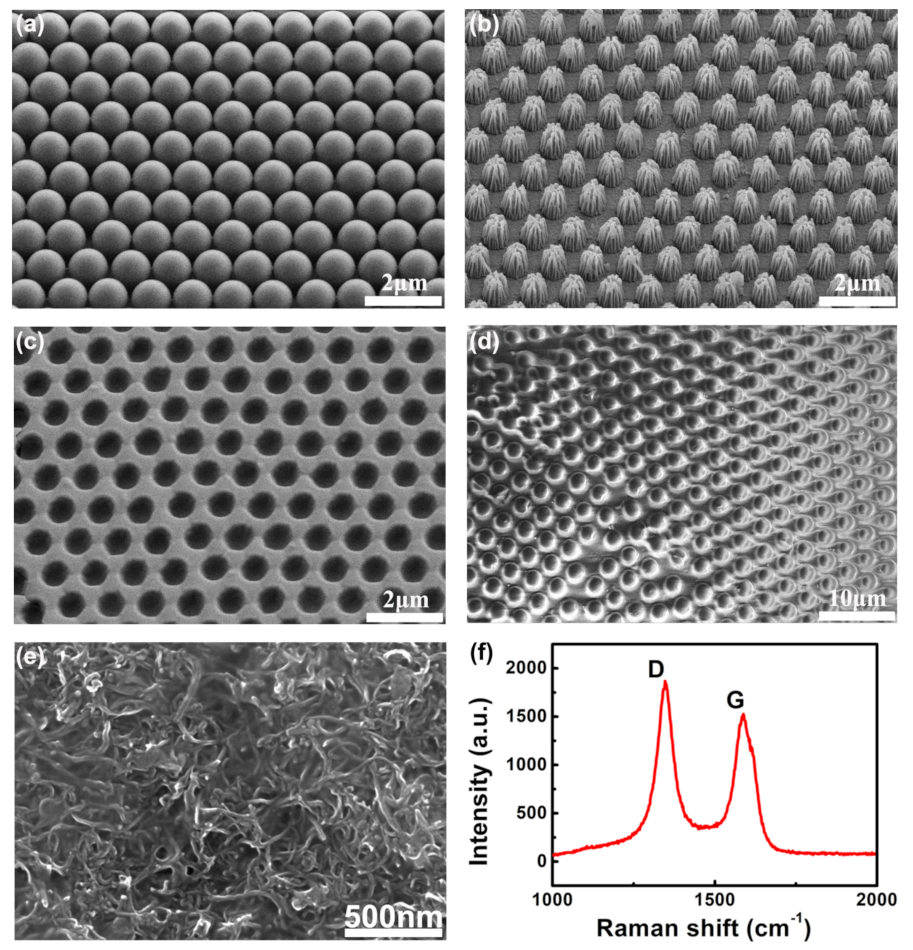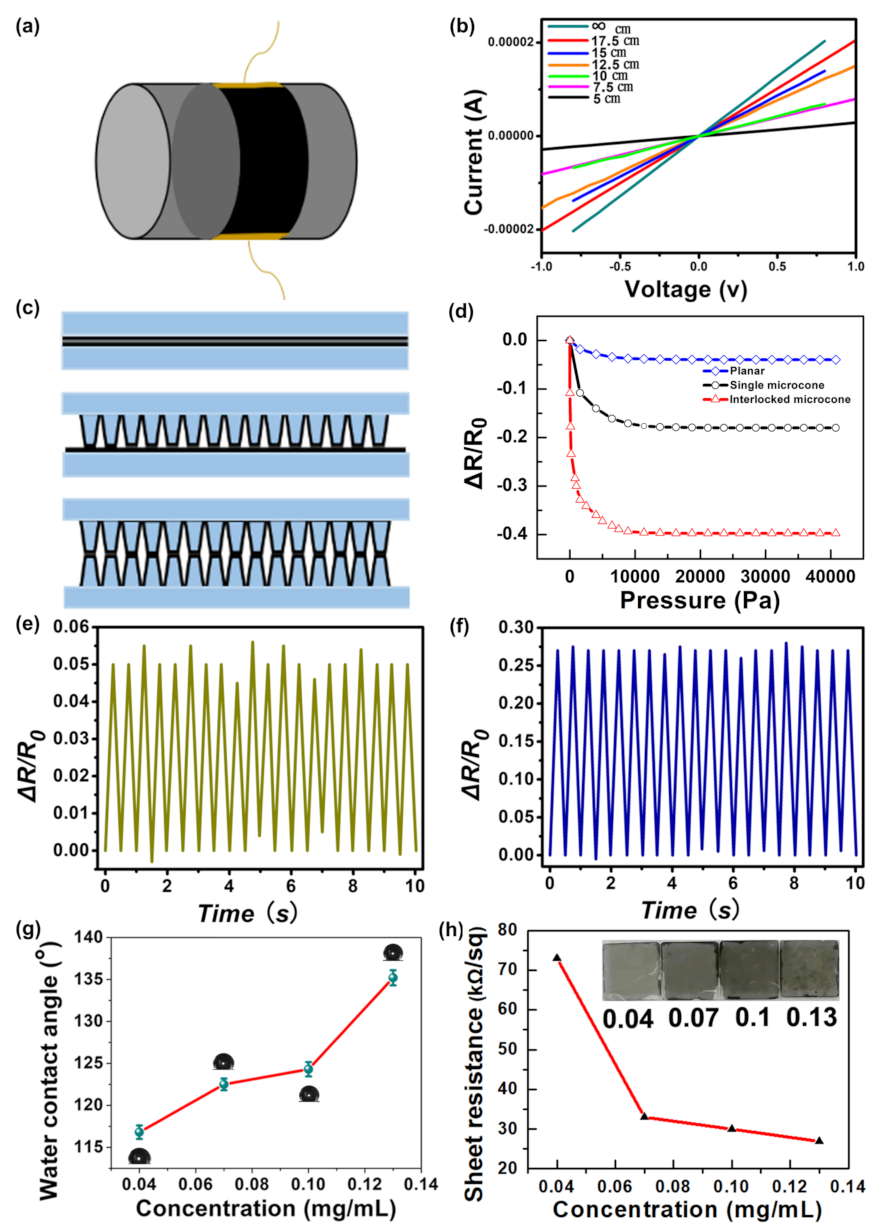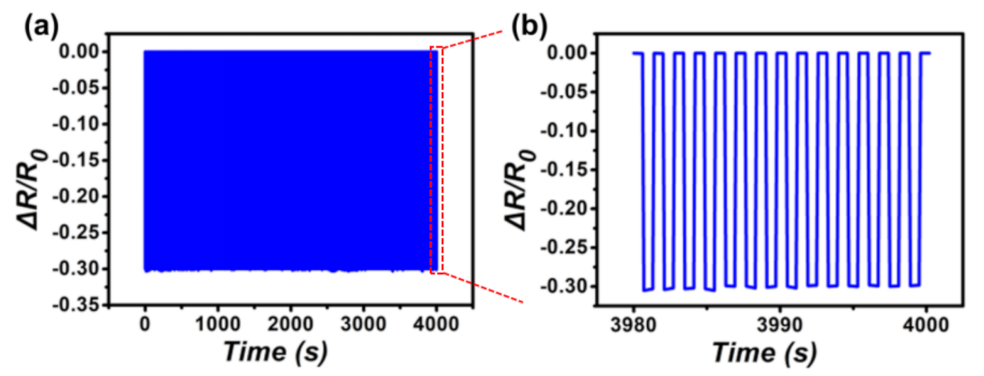Interlinked Microcone Resistive Sensors Based on Self-Assembly Carbon Nanotubes Film for Monitoring of Signals
Abstract
:1. Introduction
2. Experimental Section
2.1. Materials
2.2. Preparation of the Monolayer PS Spheres Array
2.3. Fabrication of the PDMS Film with Convex Microcone
2.4. Preparation of the Monolayer CNTs Networks
2.5. Manufacture of Flexible Pressure Sensor
2.6. Characterization and Instruments
2.7. Simulation Analysis of Interlinked Sensor
3. Results and Discussion
3.1. Sensor Design and Fabrication
3.2. Sensor Model Development
3.3. The Performance of the Interlinked Microcone Resistive Sensor
3.4. The Specific Application of the Interlinked Microcone Resistive Pressure Sensor
4. Conclusions
Author Contributions
Funding
Institutional Review Board Statement
Informed Consent Statement
Data Availability Statement
Conflicts of Interest
Sample Availability
References
- Park, S.H.; Park, J.; Park, H.N.; Park, H.M.; Song, J.Y. Flexible galvanic skin response sensor based on vertically aligned silver nanowires. Sens. Actuators B-Chem. 2018, 273, 804–808. [Google Scholar] [CrossRef]
- Someya, T.; Bao, Z.N.; Malliaras, G.G. The rise of plastic bioelectronics. Nature 2016, 540, 379–385. [Google Scholar] [CrossRef] [PubMed]
- Zhu, Y.S.; Li, J.W.; Cai, H.B.; Wu, Y.M.; Ding, H.Y.; Pan, N.; Wang, X. Highly sensitive and skin-like pressure sensor based on asymmetric double-layered structures of reduced graphite oxide. Sens. Actuators B-Chem. 2018, 255, 1262–1267. [Google Scholar] [CrossRef]
- He, H.X.; Dong, C.Y.; Fu, Y.M.; Han, W.X.; Zhao, T.M.; Xing, L.L.; Xue, X. Self-powered smelling electronic-skin based on the piezo-gas-sensor matrix for real-time monitoring the mining environment. Sens. Actuators B-Chem. 2018, 267, 392–402. [Google Scholar] [CrossRef]
- Chang, H.; Kim, S.; Jin, S.; Lee, S.W.; Yang, G.T.; Lee, K.Y.; Yi, H. Ultrasensitive and Highly Stable Resistive Pressure Sensors with Biomaterial-Incorporated Interfacial Layers for Wearable Health-Monitoring and Human-Machine Interfaces. ACS Appl. Mater. Interfaces 2018, 10, 1067–1076. [Google Scholar] [CrossRef]
- Sun, Q.J.; Zhuang, J.Q.; Venkatesh, S.; Zhou, Y.; Han, S.T.; Wu, W.; Kong, K.W.; Li, W.J.; Chen, X.; Li, R.K. Highly Sensitive and Ultrastable Skin Sensors for Biopressure and Bioforce Measurements Based on Hierarchical Microstructures. ACS Appl. Mater. Interfaces 2018, 10, 4086–4094. [Google Scholar] [CrossRef]
- Wang, Z.H.; Zhang, L.; Liu, J.; Jiang, H.; Li, C.Z. Flexible hemispheric microarrays of highly pressure-sensitive sensors based on breath figure method. Nanoscale 2018, 10, 10691–10698. [Google Scholar] [CrossRef]
- Luo, C.; Liu, N.S.; Zhang, H.; Liu, W.J.; Yue, Y.; Wang, S.L.; Rao, J.; Yang, C.; Su, J.; Jiang, X. A new approach for ultrahigh-performance piezoresistive sensor based on wrinkled PPy film with electrospun PVA nanowires as spacer. Nano Energy 2017, 41, 527–534. [Google Scholar] [CrossRef]
- Wang, J.; Lou, H.Y.; Meng, J.J.; Peng, Z.Q.; Wang, B.; Wan, J.M. Stretchable energy storage E-skin supercapacitors and body movement sensors. Sens. Actuators B-Chem. 2020, 305, 527–534. [Google Scholar] [CrossRef]
- Fan, F.R.; Lin, L.; Zhu, G.; Wu, W.Z.; Zhang, R.; Wang, Z.L. Transparent Triboelectric Nanogenerators and Self-Powered Pressure Sensors Based on Micropatterned Plastic Films. Nano Lett. 2012, 12, 3109–3114. [Google Scholar] [CrossRef] [Green Version]
- Marlinda, A.; Kamaruddin, N.H.; Fadilah, A.; Said, M.; Hamizi, N.A.; Johan, M.R. Simple dispersion of graphene incorporated rubber composite for resistive pressure sensor application. Polym. Eng. Sci. 2012, 12, 3109–3114. [Google Scholar] [CrossRef]
- Pang, C.; Lee, G.Y.; Kim, T.I.; Kim, S.M.; Kim, H.N.; Ahn, S.H.; Suh, K.Y. A flexible and highly sensitive strain-gauge sensor using reversible interlocking of nanofibres. Nat. Mater. 2012, 11, 795–801. [Google Scholar] [CrossRef] [PubMed]
- Kim, S.Y.; Park, S.; Park, H.W.; Park, D.H.; Jeong, Y.; Kim, D.H. Highly Sensitive and Multimodal All-Carbon Skin Sensors Capable of Simultaneously Detecting Tactile and Biological Stimuli. Adv. Mater. 2015, 27, 4178–4185. [Google Scholar] [CrossRef] [PubMed]
- Mahata, C.; Algadi, H.; Lee, J.; Kim, S.; Lee, T. Biomimetic-inspired micro-nano hierarchical structures for capacitive pressure sensor applications. Measurement 2020, 151, 4178–4185. [Google Scholar] [CrossRef]
- Mannsfeld, S.C.; Tee, B.C.; Stoltenberg, R.M.; Chen, C.V.; Barman, S.; Muir, B.V.; Sokolov, A.N.; Reese, C.; Bao, Z. Highly sensitive flexible pressure sensors with microstructured rubber dielectric layers. Nat. Mater. 2010, 9, 859–864. [Google Scholar] [CrossRef]
- Jin, T.; Pan, Y.; Jeon, G.J.; Yeom, H.I.; Zhang, S.; Paik, K.W.; Park, S.H.K. Ultrathin Nanofibrous Membranes Containing Insulating Microbeads for Highly Sensitive Flexible Pressure Sensors. ACS Appl. Mater. Interfaces 2020, 12, 13348–13359. [Google Scholar] [CrossRef]
- Zhang, Y.; Hu, Y.; Zhu, P.; Han, F.; Zhu, Y.; Sun, R.; Wong, C.P. Flexible and Highly Sensitive Pressure Sensor Based on Microdome-Patterned PDMS Forming with Assistance of Colloid Self-Assembly and Replica Technique for Wearable Electronics. ACS Appl. Mater. Interfaces 2017, 9, 35968–35976. [Google Scholar] [CrossRef]
- Lu, Y.; He, Y.; Qiao, J.; Niu, X.; Li, X.; Liu, H.; Liu, L. Highly Sensitive interlocked Piezoresistive Sensors Based on Ultrathin Ordered Nanocone Array Films and Their Sensitivity Simulation. ACS Appl. Mater. Interfaces 2020, 12, 55169–55180. [Google Scholar] [CrossRef]
- Niu, H.S.; Gao, S.; Yue, W.J.; Li, Y.; Zhou, W.J.; Liu, H. Highly Morphology-Controllable and Highly Sensitive Capacitive Tactile Sensor Based on Epidermis-Dermis-Inspired interlocked Asymmetric-Nanocone Arrays for Detection of Tiny Pressure. Small 2020, 16, 55169–55180. [Google Scholar] [CrossRef]
- Zhu, B.; Niu, Z.; Wang, H.; Leow, W.R.; Wang, H.; Li, Y.; Zheng, L.; Wei, J.; Huo, F.; Chen, X. Microstructured Graphene Arrays for Highly Sensitive Flexible Tactile Sensors. Small 2014, 10, 3625–3631. [Google Scholar] [CrossRef]
- Pan, L.; Chortos, A.; Yu, G.; Wang, Y.; Isaacson, S.; Allen, R.; Shi, Y.; Dauskardt, R.; Bao, Z. An ultra-sensitive resistive pressure sensor based on hollow-sphere microstructure induced elasticity in conducting polymer film. Nat. Commun. 2014, 5, 3625–3631. [Google Scholar] [CrossRef] [PubMed] [Green Version]
- Tee, B.C.K.; Chortos, A.; Dunn, R.R.; Schwartz, G.; Eason, E.; Bao, Z.A. Tunable Flexible Pressure Sensors using Microstructured Elastomer Geometries for Intuitive Electronics. Adv. Funct. Mater. 2014, 24, 5427–5434. [Google Scholar] [CrossRef]
- Su, Q.; Huang, X.; Lan, K.B.; Xue, T.; Gao, W.; Zou, Q. Highly sensitive ionic pressure sensor based on concave meniscus for electronic skin. J. Micromech. Microeng. 2020, 30, 5427–5434. [Google Scholar] [CrossRef]
- Wei, Y.; Chen, S.; Lin, Y.; Yang, Z.M.; Liu, L. Cu-Ag core-shell nanowires for electronic skin with a petal molded microstructure. J. Mater. Chem. C 2015, 3, 9594–9602. [Google Scholar] [CrossRef]
- Su, B.; Gong, S.; Ma, Z.; Yap, L.W.; Cheng, W.L. Mimosa-Inspired Design of a Flexible Pressure Sensor with Touch Sensitivity. Small 2015, 11, 1886–1891. [Google Scholar] [CrossRef]
- Shu, Y.; Tian, H.; Yang, Y.; Li, C.; Cui, Y.; Mi, W.; Li, Y.; Wang, Z.; Deng, N.; Peng, B.; et al. Surface-modified piezoresistive nanocomposite flexible pressure sensors with high sensitivity and wide linearity. Nanoscale 2015, 7, 8636–8644. [Google Scholar] [CrossRef]
- Guo, R.; Yu, Y.; Zeng, J.; Liu, X.; Zhou, X.; Niu, L.; Gao, T.; Li, K.; Yang, Y.; Zhou, F. Biomimicking Topographic Elastomeric Petals (E-Petals) for Omnidirectional Stretchable and Printable Electronics. Adv. Sci. 2015, 2, 1886–1891. [Google Scholar] [CrossRef]
- Li, T.; Luo, H.; Qin, L.; Wang, X.; Xiong, Z.; Ding, H.; Gu, Y.; Liu, Z.; Zhang, T. Flexible Capacitive Tactile Sensor Based on Micropatterned Dielectric Layer. Small 2016, 12, 5042–5048. [Google Scholar] [CrossRef]
- Seol, M.L.; Woo, J.H.; Lee, D.I.; Im, H.; Hur, J.; Choi, Y.K. Nature-Replicated Nano-in-Micro Structures for Triboelectric Energy Harvesting. Small 2014, 10, 3887–3894. [Google Scholar] [CrossRef]
- Cheng, L.; Qian, W.; Wei, L.; Zhang, H.; Zhao, T.; Li, M.; Liu, A.; Wu, H. A highly sensitive piezoresistive sensor with interlocked graphene microarrays for meticulous monitoring of human motions. J. Mater. Chem. C 2020, 8, 11525–11531. [Google Scholar] [CrossRef]
- Wu, J.; Li, H.; Lai, X.; Chen, Z.; Zeng, X. Conductive and superhydrophobic F-rGO@CNTs/chitosan aerogel for piezoresistive pressure sensor. Chem. Eng. J. 2020, 386, 123998. [Google Scholar] [CrossRef]
- Tang, Z.; Yao, D.; Hu, S.; Du, D.; Shao, W.; Tang, B.; Fan, J.M.; Tang, X.G.; Gao, J. Highly conductive, washable and super-hydrophobic wearable carbon nanotubes e-textile for vacuum pressure sensors. Sens. Actuators A Phys. 2020, 303, 111710. [Google Scholar] [CrossRef]
- Taak, S.; Rajabali, S.; Darbari, S.; Mohajerzadeh, S. High sensitive/wide dynamic range, field emission pressure sensor based on fully embedded CNTs. J. Phys. D Appl. Phys. 2014, 47, 045302. [Google Scholar] [CrossRef]
- Wu, Z.L.; Wang, S.X.; Zhang, L.H.; Hu, S.J. An analytical model and parametric study of electrical contact resistance in proton exchange membrane fuel cells. J. Power Sources 2009, 189, 1066–1073. [Google Scholar] [CrossRef]
- Chen, T.; Zhang, X.; Hu, X.; Wu, Z.; Cao, F.; Wang, X.A.; Wu, B.; Fang, X.; Xie, Y. Sensitive piezoresistive sensors using ink-modified plant fiber sponges. Chem. Eng. J. 2020, 401, 1066–1073. [Google Scholar] [CrossRef]
- Pang, Y.; Zhang, K.; Yang, Z.; Jiang, S.; Ju, Z.; Li, Y.; Wang, X.; Wang, D.; Jian, M.; Zhang, Y. Epidermis Microstructure Inspired Graphene Pressure Sensor with Random Distributed Spinosum for High Sensitivity and Large Linearity. ACS Nano 2018, 12, 2346–2354. [Google Scholar] [CrossRef]
- Yu, R.; Xia, T.; Wu, B.; Yuan, J.; Ma, L.; Cheng, G.J.; Liu, F. Highly Sensitive Flexible Piezoresistive Sensor with 3D Conductive Network. ACS Appl. Mater. Interfaces 2020, 12, 35291–35299. [Google Scholar] [CrossRef]
- Dan, L.; Shi, S.; Chung, H.J.; Elias, A. Porous Polydimethylsiloxane-Silver Nanowire Devices for Wearable Pressure Sensors. ACS Appl. Mater. Interfaces 2019, 2, 4869–4878. [Google Scholar] [CrossRef]
- Wu, Q.; Qiao, Y.; Guo, R.; Naveed, S.; Hirtz, T.; Li, X.; Fu, Y.; Wei, Y.; Deng, G.; Yang, Y.; et al. Triode-Mimicking Graphene Pressure Sensor with Positive Resistance Variation for Physiology and Motion Monitoring. ACS Nano 2020, 14, 10104–10114. [Google Scholar] [CrossRef]
- Tao, L.Q.; Zhang, K.N.; Tian, H.; Liu, Y.; Wang, D.Y.; Chen, Y.Q.; Yang, Y.; Ren, T.L. Graphene-Paper Pressure Sensor for Detecting Human Motions. ACS Nano 2017, 11, 8790–8795. [Google Scholar] [CrossRef]






| Reference | Sensitivity (kPa) | Pressure Range (kPa) | Sensing Mechanism |
|---|---|---|---|
| 17 | 0.034 | 25 | Capacitive |
| 18 | 0.055 | 10 | Capacitive |
| 19 | 0.55 | 7 | Capacitive |
| 20 | 1.12 | 40 | Capacitive |
| 21 | 15 | 5 | Resistance |
| This work | 5.4 | 10 | Resistance |
Publisher’s Note: MDPI stays neutral with regard to jurisdictional claims in published maps and institutional affiliations. |
© 2022 by the authors. Licensee MDPI, Basel, Switzerland. This article is an open access article distributed under the terms and conditions of the Creative Commons Attribution (CC BY) license (https://creativecommons.org/licenses/by/4.0/).
Share and Cite
Luo, C.-L.; Jiao, J.-Y.; Su, X.-J.; Zheng, L.-X.; Yan, W.-G.; Zhong, D.-Z. Interlinked Microcone Resistive Sensors Based on Self-Assembly Carbon Nanotubes Film for Monitoring of Signals. Nanomaterials 2022, 12, 2325. https://doi.org/10.3390/nano12142325
Luo C-L, Jiao J-Y, Su X-J, Zheng L-X, Yan W-G, Zhong D-Z. Interlinked Microcone Resistive Sensors Based on Self-Assembly Carbon Nanotubes Film for Monitoring of Signals. Nanomaterials. 2022; 12(14):2325. https://doi.org/10.3390/nano12142325
Chicago/Turabian StyleLuo, Chun-Li, Jun-Yi Jiao, Xing-Jie Su, Lin-Xin Zheng, Wei-Guo Yan, and Dong-Zhou Zhong. 2022. "Interlinked Microcone Resistive Sensors Based on Self-Assembly Carbon Nanotubes Film for Monitoring of Signals" Nanomaterials 12, no. 14: 2325. https://doi.org/10.3390/nano12142325






